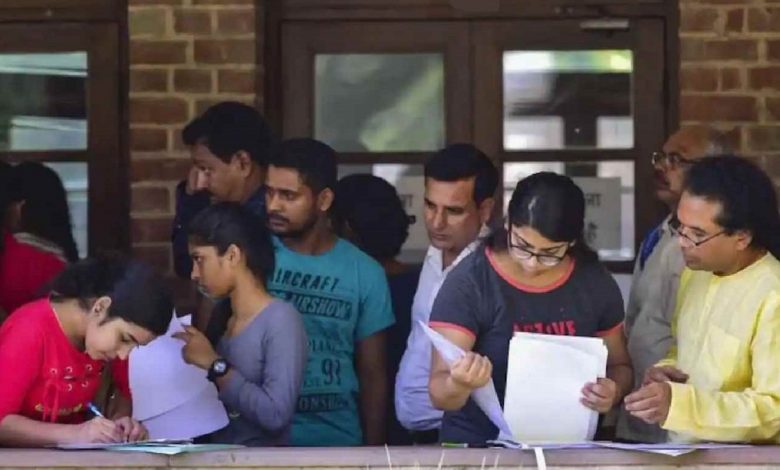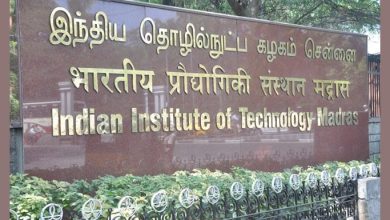From 100% Cut-Off to CUET Score, DU’s ‘unrealistic’ Merit Lists Over a Decade

CUET Score: Following the implementation of the Common University Entrance Test (CUET), Delhi University received applications for its undergraduate programs from almost 2.17 lakh individuals this year . Experts claim that as demand for DU’s undergraduate seats has increased over time, universities have increased their cut-off scores.
Prior to last year, all DU colleges admitted students based on cut-offs that were determined by the board exam results of the previous year. Many prestigious institutions admitted students with cut-off scores as high as 99% and even 100%.
Know How it Began:
Top business institution Shri Ram College of Commerce (SRCC) made news in 2009 when it announced the cut-off grades for its B.Com (Hons) programme, which ranged from 95.25 to 98.75 percent, and for its BA (Hons) Economics degree, which ranged from 93.75 to 96.75 percent. The most sought-after B.Com (Hons) course’s cut-off percentage was set at 95% in 2010 by Lady Shri Ram (LSR) College. LSR had a cut-off of 95.50 percent for BA (Hons) Economics, while SRCC was close behind with a range of 93.5 to 96.5. The Satyawati (Evening) College had the lowest cut-off percentage that year (in the second list) with 76%.
Since then, the cut-offs have skyrocketed, reaching unbelievable 99 and 100%. For B Com (Hons) admission in 2016, Ramjas College reported a cut-off of 99.25 percent, closely followed by SGTB Khalsa with a cut-off of 99 percent for BSc (Hons) in Electronics.
“The rising cut-offs are simply reducing the confidence in the system. It is not that you are thinking students are smarter, it is simply that inflation is becoming mindless,” said Pratibha Jolly, former principal of Miranda House.
Simrit Kaur, the principal of SRCC since 2017, echoed a similar view. “Two decades back, scoring first division was considered respectable, and in 70 per cent also, (students) would get admission in best of the DU colleges; the first cut-off would be in the 70s,” reminisced Kaur.
Akriti Sehgal, a student of the 2009-12 batch, said when St Stephens College published a cut-off of 94 per cent for History and LSR released the same around 89 per cent, there was a lot of buzz about it. “I feel I would have not been able to make it if I was to get admission now,” said Sehgal.
Even 90% isn’t enough
B.Com (Hons), BA (Hons) Political Science, and BA (Hons) English have historically been among of Delhi University’s most popular undergraduate programmes, drawing substantial applications and having high cut-offs. In the first list alone, several prestigious universities had all available seats filled. Even ten years ago, achieving an 80–90% score did not ensure admission to the college or course of one’s choice. The lowest cut-off for B Com (Hons) admission in 2012 was 81% at Aditi Mahavidyalaya in the second cut-off.
“The percentage has been crazy now. Earlier 80 to 85 per cent used to generally be the highest cut-off, and then around 2010-2012 the cut-off increased to 90-95 per cent, and then in 2014 or near about the cut-off soared more and since then it has been rapidly increasing. Social Sciences, about 12 years ago, were not very popular but the trend is changing and there is a high rush in every course. Students now care about getting into one of the popular colleges, and after that, they do not care about the course combinations that they might have to take,” said Anju Srivastava, principal of Hindu College.
Srivastava also recalled how BA (Hons) got more attention after DU changed its name from BA (Pass). “Since then, these courses also became popular among students. Students also understood that specialising in two subjects gives them better chances, especially in civil services,” she added.
Number mismatch
When asked about the rising cut-offs in the past decade, DU student Sehgal said, “One issue is the number of colleges. I think there is a strong need to increase the number of colleges because there is a discrepancy in the student-college ratio.”
Agreeing with this, Hindu College’s Anju Srivastava added this might be “due to the online and centralised admission. So, the application process for DU admission is more accessible now.” As a result of this, colleges “are over-admitting for no fault of ours, even with such high cut-offs,” she added.
Recalling the time when the student-teacher ratio was better, Srivastava said, “We used to remember every student’s name and where they would be sitting. The teachers’ used to connect better and they could even approach and discuss their personal problems. At this time of their life, students are at that vulnerable stage as they are familiarising themselves with the freedom they get in college. But now, we are taking them as a herd and they are not being treated the way they want and need to be treated. That is why the role of counsellors is increasing in academics. Otherwise, numbers are failing us.”
Talking about Hindu College’s cut-offs nearing 99 per cent and 100 per cent in the last decade, she said this notion seems unrealistic, but is very real. “We do not get a single moment to breathe in the first few days of admissions, because there are so many coming in from across the country, especially due to the online admissions. Last year, or before that, we had 90 students with the perfect score,” she said, trying to explain that this is the new normal where students are scoring this much.
Students’ merit, cut-off unrelated:
DU graduates and professors also said the rise in cut-off cannot be justified by colleges by saying it is designed to increase quality among students. “It would be unfair to say that these cut-offs or CUET scores can decide the quality of students because some candidates may be better at interviews and have exam phobia, while others might be better at written exams. I never felt the quality of students was an issue or was directly proportional to the cut-offs,” argued Sehgal.
MH’s Pratibha Jolly also said it would be a wrong precedent to set and that cut-offs might end up ignoring the holistic development of students. “Data analytics point towards this, but the quality of students is different and is not the main deciding factor. That is highly dependent on the holistic development of a student,” she added.
Sehgal suggested it might be a better idea if colleges conduct interviews or a spoken round to judge a student’s capability rather than depending solely on their board results or CUET score. “Earlier, the writing tests conducted by colleges used to distinguish between the writing ability in a school and in different situations. It used to check creativity, writing skills, cognitive skills and things like that of a student. Interviews work well in smaller-sized and autonomous institutions, but won’t work in DU,” argued Jolly.
“In these situations, one might look at teachers’ recommendations, micro details of internal assessments, components of exam scores in final exams, statement of purpose and more. Many private institutes and universities abroad do that. However, if we centralise everything and scale it up, it would become difficult.”
Also Read: Top Central Universities in India: Ranking List of Top 10 Central Universities in India.





